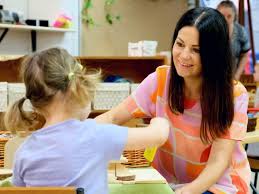As a senior corporate leader at one of Australia’s big banks, Lina Gyle knows a thing or two about managing money.
But she has not been able to find a way around the budget-busting costs of childcare for her son, Eddy.
“The childcare cost is bigger than my mortgage repayments,” she said.
“Significantly bigger, with interest rates so low.”
Without any family in Melbourne to help them, Lina said she and her husband faced out-of-pocket childcare expenses of more than $24,000 a year.
“I’m definitely not having another one because we definitely couldn’t afford another child in childcare,” she said.
“Some women don’t go back to work for five or six years because they have two kids and you just can’t afford it.”
Fellow mum Maya Linden said her $15,000 a year bill, to put her daughter Lily into childcare four days a week, completely changed her mind about having more children.
“It’s definitely a factor in us deciding to only have one child,” she said.
“We know the kind of upbringing that we want to give her, we know what the expenses are and we don’t feel we can provide the kind of upbringing we want with more than one child.”
Prestigious schools are often cheaper
For Australian parents earning the average income, childcare fees are higher than many private school fees, according to research by Victoria University (VU).
“The cost of childcare for families in Australia is among the highest in the world,” said report author Jen Jackson, the education policy lead at VU’s Mitchell Institute.
“And we’ve found that Australian families pay as much for childcare as they would to send their child to a private primary school.
“The important difference is when it comes to childcare, a lot of families don’t have a choice.”
The report said a family with both parents on the average salary of $85,000 would pay $5,782 a year out of pocket.
The non-government school sector estimates the median out-of-pocket cost for all private schools is $5,200.
Researchers say the value of quality childcare to a child’s long-term development cannot be underestimated.
While childcare centres were once considered just “drop-off zones”, research shows good early childhood educators can significantly improve outcomes for children as they progress through primary and high school.
“High-quality preschool can put a child up to eight months ahead in their learning of where they would have been without it,” Dr Jackson said.
It’s time to fund childcare like primary schools: report
The Mitchell Institute report calls for government funding of early childhood education centres — similar to that afforded to primary schools — to ensure universal access.
It is a proposal supported by Rebecca Stiles, director of the Hillbank Community Children’s Centre in Melbourne.
She is concerned about the government subsidies offered to big corporate centres which dominate the sector — particularly at a time when demand is soaring.
“Because, for them, it’s more about making that money to line their pockets and get their big advertising budgets,” she said.
Despite the billions of dollars flowing into the sector, early childhood workers are among the lowest paid in Australia.
Ms Stiles is a member of the United Workers Union which has long campaigned for pay rises.
“Educators can earn as little as $20 an hour, which is terrible given the qualifications they have,” she said.
Government to review childcare funding
Federal Education Minister Dan Tehan said the Government had already significantly increased its spending on childcare over the last decade.
“The majority of parents, over 70 per cent, are paying $5 or less an hour for childcare but I want to continue to work with the sector to put downward pressure on costs,” he said.
The report found the Federal Government more than doubled its spending from 2008 to 2018 to reach $7.7 billion.
However, at the same time, the number of families seeking a rebate skyrocketed to 852,160 families.
Mr Tehan said investment in the sector had now increased to $8.6 billion and “that will grow to $10 billion”.
Asked if the Government should consider funding childcare in the same way as primary schools, the Minister said there were “a number of ways that we could look at funding childcare”.
Reforms made almost two years ago had brought down out-of-pocket expense by 4.2 per cent, he said, but would be reviewed in the next few months to make sure costs would stay affordable.
The Mitchell Institute report said 2018 was the first year in a decade that federal government investment fell, but Mr Tehan said costs were now lower than under the previous Labor government.
While the data was opaque, the private contribution from parents could be as high as $7 billion a year, the report said.
“The Government needs to provide a guarantee that every Australian child will receive some quality early learning, irrespective of what their parents are able to pay,” Dr Jackson said.
“Yet we’ve got a Government that still won’t commit to long-term funding even for 15 hours of quality preschool for four-year-olds.”

